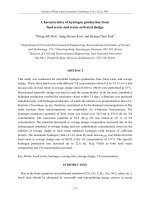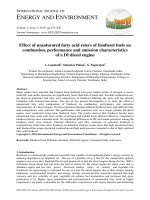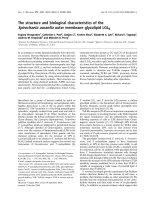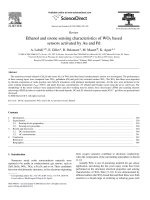- Trang chủ >>
- Khoa Học Tự Nhiên >>
- Vật lý
ethanol and ozone sensing characteristics of wo3 based sensors activated by au and pd
Bạn đang xem bản rút gọn của tài liệu. Xem và tải ngay bản đầy đủ của tài liệu tại đây (977.41 KB, 8 trang )
Sensors and Actuators B 120 (2006) 338–345
Review
Ethanol and ozone sensing characteristics of WO
3
based
sensors activated by Au and Pd
A. Labidi
a,b
, E. Gillet
a
, R. Delamare
a
, M. Maaref
b
, K. Aguir
a,∗
a
L2MP (CNRS UMR 6137), Service 152, FST St J´erˆome, Universit´e Paul CEZANNE Aix-Marseille III, 13397 Marseille Cedex 20, France
b
Unit´e de Recherche de Physique des Semiconducteurs et Capteurs, IPEST, BP 51 La Marsa 2070, Tunis, Tunisia
Received 29 November 2005; received in revised form 7 February 2006; accepted 7 February 2006
Available online 29 March 2006
Abstract
The sensitivity towards ethanol (C
2
H
6
O) and ozone (O
3
)ofWO
3
thin films based conductometric sensors was investigated. The performances
of three sensing layers were compared: bare WO
3
, palladium (Pd) and gold (Au) activated surface WO
3
. The WO
3
thin films were deposited
by thermal evaporation of oxide powders onto SiO
2
/Si transducers with platinum interdigited electrodes. All the tests were performed at the
same working temperature T
work
= 300
◦
C and under fixed gas concentrations: 2% ethanol and 0.8 ppm ozone using dry air as carrier gas. The
morphology of the sensor surfaces were analyzed before and after working runs by atomic force microscopy (AFM) and scanning electron
microscopy (SEM) in order to control the stability of the metal deposits. DC and AC electrical responses under 50 l h
−1
gas flows are presented and
discussed.
© 2006 Elsevier B.V. All rights reserved.
Keywords: DC/AC measurements; WO
3
sensor; Pd, Au activators; Ozone; Ethanol
Contents
1. Introduction 338
2. Experimental 339
2.1. Sensing device preparation 339
2.2. Sensing tests procedure 340
3. Results and discussion 340
3.1. DC measurements 340
3.2. AC measurements 341
4. Conclusion 343
References 344
Biographies 344
1. Introduction
Numerous metal oxide semiconductor materials were
reported to be usable in conductometric gas sensors, such as
ZnO, SnO
2
,WO
3
,TiO
2
, ␣-Fe
2
O
3
and so on. These candidates
have non-stoichiometric structures, so free electrons originating
∗
Corresponding author. Tel.: +33 4 91 28 89 73; fax: +33 4 91 28 89 70.
E-mail address: (K. Aguir).
from oxygen vacancies contribute to electronic conductivity
when the composition of the surrounding atmosphere is altered
[1–6].
Actually WO
3
is one of promising material for gas sensor
application, and during the last years many works have been
performed on the structural, electrical properties and sensing
characteristics of WO
3
films [7–10]. It was demonstrated by
different authors that WO
3
-based thin and thick films were both
sensitive to a broad range of oxidizing or reducing gases such
0925-4005/$ – see front matter © 2006 Elsevier B.V. All rights reserved.
doi:10.1016/j.snb.2006.02.015
A. Labidi et al. / Sensors and Actuators B 120 (2006) 338–345 339
as H
2
S [11],NO
x
[12,13],O
3
[14,15] and C
2
H
6
O [16,17].It
is well known that WO
3
like the majority of metal oxide-based
gas sensors suffer from drift and lack of selectivity, and in order
to solve these problems, a number of different strategies were
applied such as the sensor’s dynamic response analysis as well
as mixed oxides sensors for gas detection [18].
In addition to the previous cited strategies, the modification
of the metal oxide active layer by adding small amount of noble
metals has been recently emerged as a promising way for the
improvement of sensors selectivity. The metals that have been
used frequently as surface dopants for these purposes are Au,
Pt, Pd and Ag [19–23].
The main objective of our work was the understanding of
the mechanisms which explain the activation of WO
3
thin
film sensors by noble metals. For that, two metals have been
chosen Pd and Au, and their effect on the sensor sensitivity
towards ozone and ethanol was studied. The DC transient and
AC responses were analyzed in order to discriminate the sensor
parts which are crucial for the sensing mechanisms (grains–grain
boundaries–metal/oxide interfaces ). In order to avoid bulk
parameters variation the tests were carried out at the same tem-
perature T
work
= 300
◦
C. So the conductance changes that we
measured could be attributed to surface or near surface phe-
nomena.
2. Experimental
2.1. Sensing device preparation
The WO
3
sensitive layer has been grown by vapor deposi-
tion at room temperature on SiO
2
/Si transducer with platinum
interdigitated electrodes. This structure underwent a subsequent
annealing at 450
◦
C for 1 hour in dry air. In previous stud-
ies we have shown that such a fabrication process allows to
obtain continuous, well crystallized films with a stoichiometry
around WO
2.8
and an excellent stability under working con-
ditions [24,25]. The thicknesses of the WO
3
layer and of the
electrodes were 40 nm and 50 m, respectively, the area of the
Fig. 1. AFM (3 m ×3 m) micrograph of the bare WO
3
surface annealed in
dry air (1 h at 450
◦
C).
active part of the sensor being 4 mm ×4 mm. On the top of the
WO
3
, 0.5 nm (mean equivalent mass thickness) of the activator
metal (Au or Pd) was vapor deposited in UHV at T
dep
= 350
◦
C.
The morphology of each sensor was controlled by AFM
(Nanoscope III-Digital Instruments) and SEM (Phillips XL30
S5). Fig. 1 is an image of the bare WO
3
layer, which is formed
from small grains with a mean diameter of 40 nm. The mean
roughness calculated in a 1.5 m ×1.5 m area is 0.598 nm, it
remains the same after some hours of working time. It was dif-
ficult to distinguish by AFM the metals particles from the oxide
grains, so we have analyzed the activated layers by SEM. Fig. 2a
and b presents micrographs of Au/WO
3
and Pd/WO
3
surfaces,
respectively. The mean diameter of gold particles is 5 nm, the
population is homogeneous with a 6 ×10
11
cm
−2
number in
density. The size of palladium particles is larger (9 nm) with
a4×10
11
cm
−2
number in density. The three samples were
observed after the sensing tests, no changes were visible in the
metal layers as long as the working temperature (T
work
) did not
exceed the deposition temperature (T
dep
).
Fig. 2. SEM images of the sensors surfaces after deposition of metal layer (5 min at 350
◦
C). (a) Au/WO
3
and (b) Pd/WO
3
.
340 A. Labidi et al. / Sensors and Actuators B 120 (2006) 338–345
Fig. 3. Experimental set-up used for C
2
H
6
O and O
3
sensing tests.
2.2. Sensing tests procedure
Each sensor was tested separately using the same protocol
in a small chamber where the gases are injected at a flow rate
of 50 l h
−1
. Dry air was used both as a reference (baseline) and
as carrier gas to obtain the desired concentration of the detected
gas. Fig. 3 represents schematically the experimental set-up. The
dilution of C
2
H
6
O vapor in dry air was achieved using a two-arm
gas-flow device. Two mass flow controllers allowed the flow rate
of the dry air that act as the carrier gas to be controlled from 0 to
94lh
−1
in one arm (d
1
) in which the carrier gas passed through
a balloon flask containing the vapor equilibrated with 200 cm
3
of the liquid, and from 0 to 94 l h
−1
in the other arm (d
2
). The
balloon flask is put into a furnace and maintained at the fixed
temperature T
vap
=30
◦
C, in order to fix the partial pressure of
the C
2
H
6
O vapor.
In these conditions, a range of concentrations of the C
2
H
6
O
in air can be calculated by applying the following equation [26]:
[C] (%) =
xd
1
xd
1
+ d
1
+ d
2
× 100 (1)
where x is the molar fraction of the vapor in the balloon flask at
T
vap
, given by:
x =
P
vap
P
atm
(2)
with P
vap
the partial pressure of the vapor at a given temperature
T
vap
, and P
atm
the atmospheric pressure. By varying d
1
and d
2
(d
1
+ d
2
was kept constant at 50 l h
−1
), different concentration
values for C
2
H
6
O in dry air can be obtained.
For the test under O
3
the two mass flow controllers used for
C
2
H
6
O vapor will be turned off. Once this condition is satisfied,
the O
3
gas was generated by oxidizing oxygen molecules of a
dry air controlled from 0 to 50 l h
−1
in arm d
3
and fixed also at
50lh
−1
, this flow was exposed to a pen-ray UV lamp, calibrated
to give an O
3
concentration range between 0.03 and 0.8 ppm. The
total flow charged by ethanol vapor or ozone was blowing on the
sensor placed in the test chamber on a heating holder.
The working temperature (T
work
) of the sensor was controlled
by a regulated power supply connected to the heating platform.
The basic principles of the conductometric sensors is the varia-
tion of free carriers density of the active layer exposed to a gas
concentration which can be correlated to a change in conduc-
tance G of the oxide. G was measured by recording the current
variation at the applied constant DC potential V = 50 mV, with
an HP4140B Source/Pico-ammeter. In AC regime data were
acquired using a Solartron 1250 frequency response analyser
in the 0.2 Hz–65 kHz frequency range. Measurements were per-
formed at the working temperature T
work
= 300
◦
C, for 2% of
C
2
H
6
O and 0.8 ppm of O
3
.
3. Results and discussion
3.1. DC measurements
In Table 1 are reported the conductances G
0
in dry air and
G
gas
under the target gases, for the sensors WO
3
bare, Au/WO
3
and Pd/WO
3
at T
work
= 300
◦
C, and resulting sensing response
“S
gas
” of the sensors calculated by using the relations:
S
gas
=
G
gas
− G
0
G
0
for reducing gases or
S
gas
=
G
0
− G
gas
G
gas
for oxidizing gases (3)
The conductance in air the Au/WO
3
based sensor is two orders
larger than that for the bare WO
3
, when it is smaller for Pd/WO
3
.
The relative values of G
0
being as Pd/WO
3
< Au/WO
3
with G
0
(WO
3
)=5G
0
(Pd) and G
0
(Au) = 100G
0
(Pd). This indicates that
the activation mode of Au and Pd are different.
The transient responses of the three sensors towards pulses of
2% C
2
H
6
O and 0.8 ppm O
3
at 300
◦
C are compared in Fig. 4a and
b, respectively. The exposure time was kept constant at 15 min
for each test and the time between successive pulses was also
15 min. As expected under C
2
H
6
O (reducing gas) the conduc-
tance increases and it is clear that the Au/WO
3
sensor gives
A. Labidi et al. / Sensors and Actuators B 120 (2006) 338–345 341
Table 1
Response “S
gas
”ofWO
3
bare, Au/WO
3
and Pd/WO
3
based sensors towards 2% of C
2
H
6
O and 0.8 ppm O
3
atmospheres at 300
◦
C
Sensor G
0
(×10
−8
−1
) G
Ethanol
(×10
−6
−1
) G
Ozone
(×10
−9
−1
) S
Ethanol
S
Ozone
WO
3
bare 6.72 4.3 5.5 36 7.6
Au/WO
3
104 180 6.5 177 78
Pd/WO
3
1.5 0.025 11 0.76 0.15
S was calculated by using relations (3).
the largest response magnitude when bare WO
3
has the smaller
response and recovery times.
The kinetics of the responses to O
3
on bare WO
3
is normal
for an n-type semiconductor exposed to an oxidizing gas, when
on activated sensors the responses are complex (Fig. 4b): on
Pd/WO
3
, there is a rapid decrease in conductance for O
3
injec-
tion thereafter a slow conductance increase for the duration of
the pulse and a rapid increase followed by a slow decrease during
the recovery period; on Au/WO
3
, a rapid decrease in conduc-
tance at the injection is followed by a slow decrease during the
pulse, and a fast increase followed by a decrease characterizes
the recovery period. Such a kinetics results of the superposition
of two phenomena, one occurring on the bare oxide surface the
other on the metallic clusters. Further experiments at different
temperatures and concentrations are actually in progress in order
Fig. 4. Comparison of typical transient DC responses to gas pulse at 300
◦
C. (a)
2% of C
2
H
6
O and (b) 0.8 ppm of O
3
.
to clarify these mechanisms which evidently are related to the
origin of conductivity changes on activated sensors.
3.2. AC measurements
The impedance sensors response versus frequency was stud-
ied in the AC impedance spectrum following the analysis proce-
dure that was established in our previous study [27]. The WO
3
modified sensitive layers were modeled by a serial association of
three parallel RC circuits, attributed to grains (b), grains bound-
aries (gb) and grains–electrodes interfaces (el). Each RC circuit
rises to a semicircle in the complex plan plot of Z
(ω) versus
Z
(ω) (Nyquist diagram). Under small amplitudes of sinusoidal
signal, the total impedance of sensor is given by:
Z
Total
(jω) =
i
Z
i
(jω) (4)
Z
i
(jω) = Z
i
(ω) + jZ
i
(ω) (5)
where i = b, gb and el; j is the complex number j =
√
−1; Z
i
(ω),
Z
i
(ω) are the real and imaginary parts of impedance Z
i
(jω),
respectively.
In Fig. 5a and b, we report the Nyquist response of the three
sensors with modeling at T
work
= 300
◦
C, under 2% of C
2
H
6
O
vapor as well as under 0.8 ppm of O
3
, wherein the modeled
curves were made using “Equivalent Circuit” software [28].
The results of modeling for C
2
H
6
O and O
3
were reported in
Tables 2 and 3, respectively; they confirm the DC analyses,
the best response was obtained by the sensor doped by gold
(Au/WO
3
) which became practically conductor under ethanol.
The RC modeling show the existence of two semicircles
under dry air, contrary to the sensor without metals (WO
3
bare)
that gives only one semicircle either under dry air or C
2
H
6
O.
The first semicircle is attributed to WO
3
surface and bulk phe-
nomena, the second one could be attributed probably to the
carrier exchanges in the Au/WO
3
grains boundaries, because
under dry air this circle appears only when Au is added to the
WO
3
surface. When ethanol is introduced the second semicircle
disappears, this is could be explained by the fact that the pre-
adsorbed oxygen on the WO
3
and/or Au surfaces and in their
grain boundaries, is consumed by the C
2
H
6
O oxidation follow-
ing the reaction paths (6) and (7) [29]:
C
2
H
5
OH
(vap)
+ O
−
(ads)
↔ CH
3
CHO
(ads)
+ H
2
O
(vap)
+ e
−
(6)
CH
3
CHO
(ads)
+O
(lattice)
↔ CH
3
COOH
(vap)
+V
O
(7)
The electrons produced by this reaction are injected into the con-
duction band of WO
3
, which induces a decrease of the resistance.
The response to the C
2
H
6
O is improved for sensor (Au/WO
3
),
342 A. Labidi et al. / Sensors and Actuators B 120 (2006) 338–345
Fig. 5. Impedance measurements (symbols) and modeling (lines) at 300
◦
C. (a) 2% of C
2
H
6
O and (b) 0.8 ppm of O
3
.
A. Labidi et al. / Sensors and Actuators B 120 (2006) 338–345 343
Table 2
Modeled RC for WO
3
bare, Au/WO
3
and Pd/WO
3
based sensors towards 2% of C
2
H
6
O and dry air (baseline) at 300
◦
C
2% of Ethanol (C
2
H
6
O)
WO
3
a
WO
3
+Au
a
WO
3
+Pd
a
Dry air
b
Ethanol
b
Dry air
b
Ethanol
b
Dry air
b
Ethanol
b
R
s-b
(×10
6
) 15.77 0.2 1.46 0.005 59.17 37.23
C
b
(×10
−10
F) 1.65 1.87 1.72 1.22 1.65 1.78
n 0.993 0.986 0.991 0.971 0.986 0.975
R
gb
(×10
6
) 0.018 2.37
C
gb
(×10
−7
F) 1.81 6.81
n 0.967 0.433
a
Sensors.
b
Gases.
Table 3
Modeled RC for WO
3
bare, Au/WO
3
and Pd/WO
3
based sensors towards 0.8 ppm of O
3
and dry air (baseline) at 300
◦
C
0.8 ppm of Ozone (O
3
)
WO
3
a
WO
3
+Au
a
WO
3
+Pd
a
Dry air
b
O
3
b
Dry air
b
O
3
b
Dry air
b
O
3
b
R
s-b
(×10
6
) 20.62 157.56 2.1 259.14 82.12 82.94
C
b
(×10
−10
F) 1.61 1.65 1.7 1.64 1.65 1.6
n 0.997 0.993 0.992 0.990 0.986 0.992
R
gb
(×10
6
) 0.028 53.42
C
gb
(×10
−7
F) 1.98 0.1
n 0.992 0.726
a
Sensors.
b
Gases.
an opposite result was obtained with the addition of Pd to the
WO
3
surface, i.e. increase of resistance and decrease of sensi-
tivity. This could be caused by the oxidation of palladium on the
surface or by the formation of a bimetallic component as it was
found on SnO
2
and CeO
2
[30–32].
Under O
3
the sensor Au/WO
3
gives also the best response
with a more pronounced grain boundaries effect. The transient
responses of Fig. 4b, suggested that one of the two steps of the
reaction (8) resulting of the O
3
dissociation is enhanced by the
presence of the metal particles [33–35].
p
2
O
2
+∗↔O
p(ads)
adsorption step
O
p(ads)
+ qe ↔ O
q−
p(ads)
electron transfer step
(8)
The AC analysis evidenced that it is the electron transfer step
which is improved, in effect when O
3
is introduced the RC mod-
eling shows a decrease of the grains boundaries capacitance due
to the increases of the depletion zone and consequently increases
the resistance and the electrons capture by oxygen through the
interface Au/WO
3
. In this case the conductance is mainly con-
trolled by the grains boundaries phenomena, i.e. by the electron
transfer step in these regions, which is confirmed by the appari-
tion of a second deformed semicircle. Fig. 5b shows that the
model with two circles, whose results are reproduced in Table 2,
represents well the experimental results at the high frequencies
(first semicircle). The more important variation observed at the
low frequencies between the experimental model and results can
be due to the existence of athird semicircle, due to theapparitions
of some diffusions phenomena in the interface grains/electrode
(Pt). Unfortunately our work frequency range, does not allow us
to modeling this third semicircle, that is why we have a small
deviation between AC measurements and modeling in the low
frequency range, as illustrated in Fig. 5b, for the sensor doped
with Au (Au/WO
3
).
The other important remark is the non-sensitivity of the Pd-
doped WO
3
gas sensor, which became practically insensitive to
the O
3
gas. The origin of such a behavior should be the adverse
effect of the PdO formation on the free carrier density.
4. Conclusion
Au has been found a good sensing activator for WO
3
thin
films. The sensitivities of Au/WO
3
sensors to ethanol and ozone
are in the 2/1 ratio; therefore, at a working point of 300
◦
C they
can provide a stable, sensitive element for ethanol gas. On the
contrary Pd/WO
3
sensors are practically insensitive in this tem-
perature range to the tested gases and in these senses could be
used as selective elements against ozone. The characteristics
of the dynamic responses of the activated WO
3
thin films sug-
gest complex phenomena which depend on the strength of the
metal–substrate interaction and consequently could be induced
by the formation of oxide or bimetallic species on the metal par-
ticles. In the actual knowledge state in the behavior of doped
344 A. Labidi et al. / Sensors and Actuators B 120 (2006) 338–345
oxide layers one needs an understanding of activation processes
at an atomic level if one want to progress in the design of
predictable sensing properties. In this way we have initiated a
research by XPS and synchrotron radiation photoelectron spec-
troscopy (SRPES) in order to elucidate the electronic structure
of the atomic species under various working conditions.
References
[1] W. G
¨
opel, Chemisorption and charge transfer at ionic semiconductor sur-
faces: implication in designing gas sensors, Prog. Surf. Sci. 20 (1) (1985).
[2] M.J. Madou, S.R. Morrison, Chemical Sensing with Solid state Devices,
Academic, San Diego, 1989.
[3] K.D. Schierbaum, U. Weimar, W. G
¨
opal, R. Kowalkowski, Conductance,
work function and catalytic activity of SnO
2
-based gas sensors, Sens. Actu-
ators B 3 (1991) 205–214.
[4] K.D. Schierbaum, Engineering of oxide surfaces and metal/oxide inter-
faces for chemical sensors: recent trends, Sens. Actuators B 24/25 (1995)
239–247.
[5] Y.K. Chung, M.H. Kim, W.S. Um, H.S. Lee, J.K. Song, S.C. Choi, K.M. Yi,
M.J. Lee, K.W. Chung, Gas sensing properties of WO
3
thick film for NO
2
gas dependent on process condition, Sens. Actuators B 60 (1999) 49–56.
[6] P. Moseley, B. Tofield, Solid State Gas Sensors, Adam Hilger, Bristol, UK,
1987.
[7] M. Regragui, V. Jousseaume, M. Addou, A. Outzourhit, J.C. Bern
´
ede, B.
El Idrissi, Electrical and optical properties of WO
3
thin films, Thin Solid
Films 397 (2001) 238–243.
[8] W. Yu-De, C. Zhan-Xian, L. Yan-Feng, Z. Zhen-Lai, W. Xing-Hui, Electri-
cal and gas-sensing properties of WO
3
semiconductor material, Solid-State
Electron. 45 (2001) 639–644.
[9] M. Stankova, X. vilanova, E. Llobet, J. Calderer, C. Bittencourt, J.J.
Pireaux, X. Correig, Influence of the annealing and operating tempera-
ture on the gas-sensing properties of rf sputtered WO
3
thin-film sensors,
Sens. Actuators B 105 (2005) 271–277.
[10] M. Gillet, K. Aguir, C. Lemire, E. Gillet, K. Schierbaum, The structure and
electrical conductivity of vacuum-annealed WO
3
thin films, Thin Solid
Films 467 (2004) 239–246.
[11] D.J. Dwyer, Surface chemistry of gas sensors: H
2
SonWO
3
films, Sens.
Actuators B 5 (1991) 155–159.
[12] G. Sberveglieri, L.E. Depero, S. Groppelli, P. Nelli, WO
3
sputtered thin
films for NO
x
monitoring, Sens. Actuators B 84 (2002) 1–5.
[13] D.S. Lee, S.D. Han, J.S. Huh, D.D. Lee, Nitrogen oxides sensing charac-
teristics of O
3
-based nanocrystalline thick film gas sensor, Sens. Actuators
B 60 (1999) 57–63.
[14] K. Aguir, C. Lemire, D.B.B. Lollman, Electrical properties of reactively
sputtered WO
3
thin films as ozone gas sensor, Sens. Actuators B 84 (2002)
1–5.
[15] M. Bendahan, R. Boulmani, J.L. Seguin, K. Aguir, Characterization of
ozone sensors based on WO
3
reactively sputtered films: influence of O
2
concentration in the sputtering gas, and working temperature, Sens. Actu-
ators B 100 (2004) 320–324.
[16] R. Ionescu, A. Hoel, C.G. Granqvist, E. Llobet, P. Heszler, Ethanol and H
2
S
gas detection in air and in reducing and oxidising ambience: application
of pattern recognition to analyse the out p from temperature-modulated
nanoparticulate WO
3
gas sensors, Sens. Actuators B 104 (2005) 124–131.
[17] B.P.J. de Lacy Costello, R. Ewen, H. Gunson, N. Ratcliffe, P. Spencer, The
development of sensor system for the early detection of soft rot in stored
potato tubers, Meas. Sci. Technol. 11 (2000) 1685–1691.
[18] K. Zakrzewska, Mixed oxides as gas sensors, Thin Solid Films 391 (2001)
229–238.
[19] G. Sberveglieri, Recent developments in semiconducting thin-film gas sen-
sors, Sens. Actuators B 23 (1995) 103–109.
[20] P. Ivanov, E. Llobet, X. Vilanova, J. Brezmes, J. Hubalek, X. Correig,
Development of high sensitivity ethanol gas sensors based on Pt-doped
SnO
2
surfaces, Sens. Actuators B 99 (2004) 201–206.
[21] M. Schweizer-Berberich, J.G. Zheng, U. Weimar, W. G
¨
opel, N. B
ˆ
arsan, E.
Pentia, A. Tomescu, The effect of Pt and Pd surface doping on the response
of nanocrystalline tin dioxide gas sensors to CO, Sens. Actuators B 31
(1996) 71–75.
[22] I. Stambolova, K. Konstantinov, S. Vassilev, P. Peshev, Ts. Tsacheva, Lan-
thanum doped SnO
2
and ZnO thin films sensitive to ethanol and humidity,
Mater. Chem. Phys. 63 (2000) 104–108.
[23] P.J. Shaver, Activated tungsten oxide gas detectors, Appl. Phys. Lett. 11
(1967) 7–255.
[24] C. Lemire, Elaboration et caracterisation de films minces de WO
3
en vue
de leur application comme capteur de gaz, Thesis-Universit
´
e Aix-Marseille
III, 2001.
[25] C. Bittencourt, R. Landers, E. Llobet, G. Molas, X. Crreig, M.A.P. Silva,
J.E. Sueiras, J. Calderer, Effect of oxygen partial pressure and annealing
temperature on the formation of sputtered tungsten oxide films, J. Elec-
trochem. Soc. 149 (3) (2002) H81–H86.
[26] A. Abdelghani, N. Jaffrezic-Renault, SPR fibre sensor sensitized by fluo-
rosiloxane polymers, Sens. Actuators B 74 (2001) 117–123.
[27] A. Labidi, C. Jacolin, M. Bendahan, A. Abdelghani, J. G
´
erin, K. Aguir, M.
Maaref, Impedance spectroscopy on WO
3
gas sensor, Sens. Actuators B
106 (2005) 713–718.
[28] B.A. Boukamp, Equivalent Circuit (EQUIVCRT.PAS), University of
Twente, The Netherlands, 1990.
[29] F. Hellegouarc’h, F. Arefi-Khonsari, R. Planade, J. Amouroux, PECVD
prepared SnO
2
thin films for ethanol sensors, Sens. Actuators B 73 (2001)
27–34.
[30] N. Tsud, V. Joh
´
anek, I. Star
´
a, K. Veltrusk
´
a, V. Matolin, XPS, ISS and TPD
study of Pd·Sn interactions on Pd–SnO
x
systems, Thin Solid Films 391
(2001) 204–208.
[31] L. Kepi
´
n, Carbon deposition in Pd/CeO
2
catalyst: TEM study, Catal. Today
50 (1999) 237–245.
[32] T. Sk
´
ala, K. Veltrusk
´
a, M. Moroseac, I. Matolinov
´
a, A. Cirera, V. Matolin,
Redox process of Pd–SnO
2
system studied by XPS, in: Proceeding of 22nd
European Conference on Surface Science, Prague, Czech Republic, Poster
N
◦
. 16931, 2003.
[33] W. Li, S.T. Oyama, Mechanism of ozone decomposition on a maganese
oxide catalyst (1), J. Am. Chem. Soc. 120 (1998) 9041–9046.
[34] W. Li, G.V. Gibbs, S.T. Oyama, Mechanism of ozone decomposition on a
maganese oxide catalyst (2), J. Am. Chem. Soc. 120 (1998) 9047–9052.
[35] A. Gurlo, N. Bars
ˆ
an, M. Ivanovskaya, U. Weimar, W. G
¨
opel, In
2
O
3
and
MoO
3
thin film semiconductor sensors: interaction with NO
2
and O
3
, Sens.
Actuators B 47 (1998) 92–99.
Biographies
Ahmed Labidi, was born in La Marsa, Tunis, Tunisia in 1975. He received the
DEA (post-graduate diploma) in quantum physics 2002 from the University of
Tunis El Manar (Tunis, Tunisia). He is currently preparing his PhD degree in
physics and Materials science in the L2MP laboratory at the Paul CEZANNE,
Aix-Marseille III University (France), in cooperation with the URPSC Labora-
tory at the 7 November University (Tunisia). His research interest is the electrical
studies of the WO
3
gas sensors under oxidizing and reducing gases by impedance
spectroscopy.
Eveline Gillet, born in 1937, graduated from the University of Poitiers (France),
Docteur
`
es Sciences (Universit
´
e de Provence-1969). She is Professor in Physics
at Paul C
´
ezanne University – Aix-Marseille (France). She worked in the area
of Surface Science. In particular she studied chemisorption on transition metal
nanoparticles (model catalysts). Actually she is involved in a research devoted to
the electrical properties of nanostructured metal oxide semiconductor thin films
and nanorods for applications to new sensing devices.
Romain Delamare, was born in 1973. He is professor assistant at Paul
CEZANNE, Aix Marseille III University (France). He was awarded his PhD
degree in semiconductors physic from University of Orl
´
eans (France) in 2003.
His principal research interests are now directed towards WO
3
gas sensors and
selectivity enhancement strategies including noise spectroscopy and modelling
of sensor responses.
A. Labidi et al. / Sensors and Actuators B 120 (2006) 338–345 345
Mhamed Ali Maaref, was born in 1955. He is professor in Solid State Physics
at the Engineering Institute of Tunis (INSAT) in 2000. He was awarded his
Doctorat d’Etat in semiconductors from University of Tunis (Tunisia) in 1994.
He is head of research group in Semiconductor Physics and Sensors at the
Institute of Science and Technology (IPEST) University 7 Novembre (Tunisia).
His principal research activities are involved on III/V semiconductors materials:
Study by reflectivity and luminescence of GaAs/AlAs Super-lattices, Quantum
Wells and self organized InAs/GaAs Quantum dots elaborated by MBE.
Khalifa aguir, was born in 1953. He is professor at Paul CEZANNE – Aix Mar-
seille III University (France). He was awarded his Doctorat d’Etat
`
es Science
degree from Paul Sabatier University Toulouse (France) in 1987. He is currently
head of Sensors Group at Laboratoire Mat
´
eriaux & Micro
´
electronique (L2MP-
CNRS) Marseille (France). His principal research interests are now directed
towards WO
3
gas sensors and multisensors and selectivity enhancement strate-
gies including PCA analysis and nose spectroscopy; and modelling of sensor
responses.









